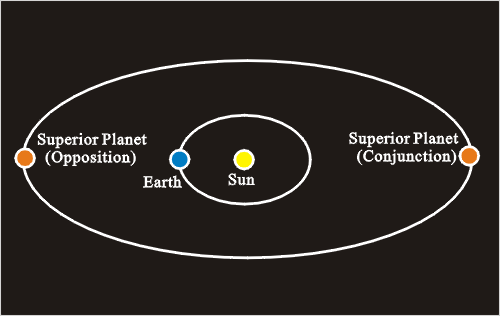What is Opposition of Jupiter?
What is Opposition of Jupiter?
Opposition of Superior Planets
A superior planet revolves around the Sun in an orbit further away from the Sun than the Earth. Mars, Jupiter, Saturn, Uranus and Neptune are superior planets in the Solar System.
When a superior planet, the Earth and the Sun align in a straight line with the Earth in between, it is known as opposition. When the superior planet and the Earth lie on the opposite sides of the Sun, it is known as conjunction (Figure 1). During opposition, the superior planet will be closest to the Earth and it would be a suitable time for observing the superior planet.

Figure 1 Relative positions of a superior planet, the Earth and the Sun during opposition and conjunction of the superior planet.
Opposition of Jupiter
Jupiter is the largest planet in the Solar System and the fifth planet away from the Sun. Jupiter is characterized by the brightly coloured bands on its surface and the Great Red Spot near the equator.
Jupiter revolves around the Sun with a period of about 11.86 years. In ancient China, the year was counted according to the position of Jupiter on the celestial sphere, and matched to the 12 Earthly Branches. So Jupiter is also known as the Age Star. Opposition of Jupiter will occur about once every 399 days. The last Jupiter opposition was on 4 March 2004.
Jupiter is the second brightest planet after Venus. A few weeks before and after the opposition on 4 March 2004, Jupiter will be very bright, reaching a visual magnitude of about -2.5*. This will be a good time to observe Jupiter, its Great Red Spot and Jupiter's four largest satellites namely Io, Europa, Ganymede and Callisto. A telescope with a magnification of 40 times or above is preferred in observing Jupiter.
* Visual magnitude is a measure of the brightness of a celestial object. The visual magnitude of a faint star is large and positive. The brighter a star is, the smaller the visual magnitude will be. The brightest celestial objects will have negative magnitudes (visual magnitudes for the Sun and full moon are -26.8 and -12.5 respectively). In a clear night, the faintest stars that can be observed by naked eyes in the countryside would have a magnitude of around +6.